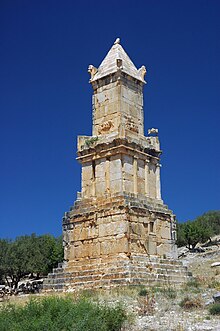Pillar tomb in Thugga
The pillar tomb in Thugga , also the tower mausoleum of Ataban , was built in the 2nd century BC. In the ancient city of Thugga in North Africa in what is now Tunisia . It is known for its good preservation and its bilingual inscription , which led to the deciphering of the Numidian script .

The pillar grave at the southern lower end of the city is 21 meters high and was built from local limestone. A basement is built on a five-level base, which is framed by Aeolian corner pilasters. The actual grave was housed in this construction stage. Above this is a central part, which is adorned on each of the four sides by Ionic half-columns. The third floor above is framed by Aeolian corner pilasters like the grave floor. There are also diagonal pedestals for equestrian statues on the corners and square reliefs on the side walls. A roof in the shape of a pyramid forms the end. The roof is crowned by a lion figure, at the corners there are four winged women as acroter figures . There are contemporary and ancient designs side by side. The dating is based on the inscription. The building is largely preserved. In 1842 it was torn down to the first floor by the English consul in Tunis , Sir Thomas Reade , in order to get to the inscription which is now kept in the British Museum in London (inventory numbers 494 and 495). From 1908 to 1910 the tomb was completely rebuilt under the direction of Louis Poinssot .
In addition to its good preservation, the building is famous for its inscription on the basement, which has been known in Europe since 1631. The bilingual lists the craftsmen involved in the construction and their function in two seven-line identical texts in Numidian and Punic . Aṭban (Ataban) was probably the architect. The stonemasons ʿAbdarisch , Zimer and Managai , their assistants Zazai , Tamôn and Warsakan , the carpenters Masidil and Ankan and the ironworkers Schafot and Papai were also listed. There is a gap at the beginning of the inscription, which is why it was interpreted differently. Some researchers assume that it is a tomb of a prince named Aṭban. The filiation (descent) from Zimer to Aṭban to his great-grandfather speaks against it, as does the lack of princely titles and the performance of the craftsmen involved in the construction. In addition, a travelogue from 1815 mentions a second inscription that was lost today and was already in poor condition at the time, which probably named the owner of the grave. The bilingual inscription was the basis for deciphering the Numidian script and for understanding individual words.
The archaeological site of Thugga, to which the pillar tomb belongs, has been a UNESCO World Heritage Site since January 17th, 2012 .
literature
- Louis Poinssot: La restauration du mausolée de Dougga. In: Comptes rendus de l'Académie des inscriptions et belles-lettres 1910, pp. 780-787 full text
- Jan-Willem Salomoson, Claude Poinssot: Le mausolée libyco-punique de Dougga et les papiers du comte Borgia. In: Comptes rendus de l'Académie des inscriptions et belles-lettres 1959, pp. 141-149 full text
- Christian Leschke: Aṭban . In: Rainer Vollkommer (Hrsg.): Künstlerlexikon der Antike . Volume 1: A-K. Saur, Munich / Leipzig 2001, ISBN 3-598-11413-3 , pp. 101-102.
Web links
- Mausolee Dougga (1931) , exhibit from the color photo collection “The wonderful world of Albert Kahn” in the Albert Kahn Museum, Paris.
Individual evidence
- ^ Jean-Baptiste Chabot: Recueil des inscriptions libyques. Imprimerie Nationale, Paris 1940, No. 1; Herbert Donner , Wolfgang Röllig (Ed.): Canaanite and Aramaic inscriptions. 5th expanded and revised edition. Volume 1. Harrassowitz, Wiesbaden 2002, No. 100.
- ^ Mohamed Chafik: Initiation au Tifinagh. In: Revue Tifinagh 1 (1993/94) 5-15, here: p. 8 ( online ).
Coordinates: 36 ° 25 ′ 13.1 ″ N , 9 ° 13 ′ 12.7 ″ E


